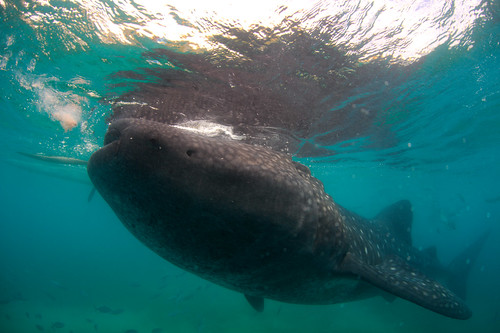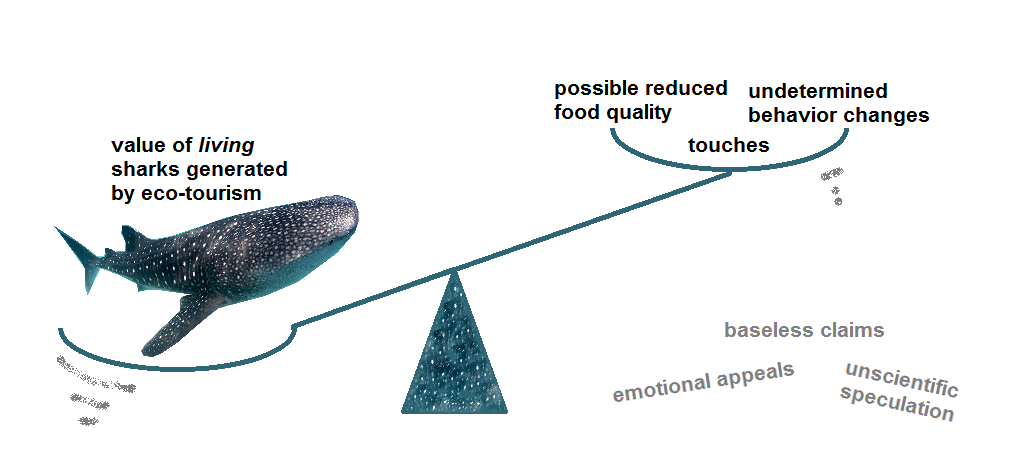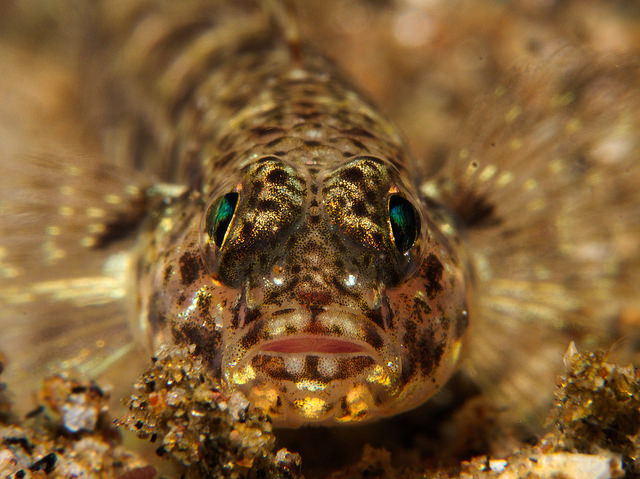Oslob Controversy
In Oslob, Cebu, Philippines, several whale sharks convene every morning to feed on plankton provided by former local fishermen from small boats. This offers a unique experience to spend time up close with these gentle giants.
However, does the feeding harm the sharks? There has been quite some controversy surrounding this question. We think the potential damage is relatively minor and it creates an incentive for the local fishermen to let the sharks live. Read the arguments about the whale shark encounter in Oslob, informed by studies of whale sharks and other sharks & ray species fed for tourists.

|
The argument |
What I respond, based on science |
|
Touching whale sharks is bad. |
Yes, I agree. It’s not as bad as touching bony fishes with their mucous-covered skins, but it can lead to abrasions. I agree 100% with the policy in Oslob not to touch sharks. The touches we observe, mainly from snorkelers, are relatively rare and minor. I’d also like to point out: Whale sharks have survived tiger shark attacks. A snorkeler touching one will not kill it. |
|
Strobes for underwater photography are bad for whale sharks. |
Whale sharks are not very visual animals, with small, sidewards-pointing eyes. Still, it’s presumably not a good thing to blast them with bright light all morning long. I agree with the policy in Oslob to disallow strobes. Besides, strobes are not necessary in the shallow water the whale sharks swim in, if you are a good photographer. |
|
Bubbles from divers are bad for sharks. |
As far as I am aware, there is absolutely no evidence that this is the case. |
|
I would not want to have 100 people watch me eating every day. |
A shark is not a person with fins and gills. This mistake in reasoning is called “anthropo-morphizing”. The sharks knows of no such notions as privacy and shame. They most likely don’t care at all about us watching them eating. |
|
I did not enjoy being in the water with so many people. What a circus! |
That might be, but it has absolutely nothing to do with the well-being of the whale sharks. It’s not a statement about shark conservation biology, but about your likes and preferences. |
|
The whale shark feeding leads to habituation of sharks to boats. They will hence collide with boats outside of the feeding area. |
I don’t think that’s very likely. Yes, white tip reef sharks in Australia have been shown to associate the sound of boat engines with food. But, the boats in Oslob are small row-boats, without engines. These will not lead the sharks to associate cargo ships or ferries with food. Yes, whale sharks with injuries have been seen in Oslob. But are they a consequence of the feeding? In sites remote from any feeding spots in the Seychelles, many injured whale sharks were observed as well. Unfortunately, whale shark – boat collisions are common word-wide, independently of feeding. |
|
Shark behavior is altered by the feeding. |
Yes, the feeding will cause some shark behavior changes. So does (over)fishing, coastal development and ocean pollution. Humans have altered shark behavior since they have started fishing the oceans in mid-stone age. The question is, how drastic are these changes, and are they harmful to the sharks? The known effects of human-shark interactions are mixed: The long-range migration patterns of tiger sharks in the Caribbean are unaltered by feeding. Great white sharks in South Africa initially swim closer to the surface, but usually lose interest in baits after a few encounters. Lemon sharks in Fiji changed their diurnal patterns in response to feeding. The behavioral changes of the whale sharks in Oslob are insufficiently understood in our opinion. I do not have the impression that any of the known changes of shark behavior in response to feeding are negative and dramatic. I am not aware of a single case where shark feeding has led to the collapse of a shark population (“shark feeding kills sharks”). |
|
The upright position the whale sharks take when they feed in Oslob is unnatural. |
This is not true. Vertical postures from feeding whale sharks have been seen in Baja California, on the Pacific side of Mexico and other locations. |
|
The whale sharks are trapped in Oslob by the feeding. |
The whale sharks are not in an enclosure, and can leave anytime they decide to, which they do every afternoon after the feeding stops for the day. |
|
Whale shark reproduction is altered by the feeding. |
As shark behavior generally, shark reproduction can be altered by feeding, in several ways. In Grand Cayman, stingrays established a new mating site in response to feeding, presumably leading to more reproduction. In Fiji, lemon shark numbers at feeding sites drop during the mating season, indicating that the sharks mate despite the option to be fed. Very young whale sharks (< 2 m) have appeared in Oslob, a cautious sign that the whale shark population visiting Oslob reproduces. |
|
Feeding the whale sharks leads to unhealthy nutrition for the sharks. |
This could be the case. Some of the shrimp used to feed the whale sharks is from outside of Oslob; this could affect food freshness and quality. Fed stingrays in the Caribbean have indeed been shown to be in somewhat poorer health due to the food they receive. However, the whale sharks in Oslob are only fed in the morning and leave the bay afterwards. They certainly have opportunity to forage for other food sources then. We don’t know the proportion of foraged/fed food they get. |
|
The whale sharks will become dependent on humans for their food. |
As far as I know, there is no evidence from any fed shark species that the animals “forgot how to feed for themselves”. |
|
The whale shark feeding has a positive socio-economic impact. |
I completely agree. Shark populations world-wide are under threat from over-fishing. The shark tourism in Oslob provides a financial motivation to the locals to leave the sharks alive. That’s a very big deal in a poor country like the Philippines! |
In conclusion, I believe that the whale shark feeding is not ideal, but not drastically detrimental to the well-being of the sharks either. In relation to the approximately 38 million sharks killed per year, feeding a few of them does not strike us as a bad problem. We think that the socio-economic effects, motivating the locals to keep the sharks alive, outweigh the negative effects.
I have the impression that many arguments critical of the whale shark feeding are based on an emotional disappointment after having to “share” the sharks with a crowd, and are not based on conservation biology. We still think that despite not being alone with the whale sharks, witnessing the shark feeding in Oslob can be an enjoyable experience.
I favor a carefully managed whale shark experience in Oslob rather than an uninformed vilification of the practice. The management of the shark encounter has significantly improved since the practice started in 2010.
Here is some scientific literature to support the arguments above. And, yes, if I have missed anything significant in my arguments, we would like to hear about it! klaus@savedra.com
Chapman, D.D., Corcoran, M.J., Harvey, G.M., Malan, S., Shivji, M.S., 2003. Mating Behavior of Southern Stingrays, Dasyatis americana (Dasyatidae). Environmental Biology of Fishes 68, 241–245.
New stingray mating sites emerged as a result of feeding.
Fitzpatrick, B., Meekan, M., Richards, A., 2006. Shark attacks on a whale shark (Rhincodon typus) at Ningaloo Reef, western Australia, Bulletin of Marine Science, Volume 78, 97-402 (6)
Whale sharks have survived tiger shark attacks. Gruesome pictures in this study.
Fitzpatrick, R., Abrantes, K.G., Seymour, J., Barnett, A., 2011. Variation in depth of whitetip reef sharks: does provisioning ecotourism change their behaviour? Coral Reefs 30, 569–577.
White tip reef shark behavior in the coral sea has changed in response to feeding; among other things they have learned to associate boat engine noises with food.
Gallagher, A.J., Hammerschlag, N., 2011. Global shark currency: the distribution, frequency, and economic value of shark ecotourism. Current Issues in Tourism.
The financial gain for otherwise poor tropical communities from shark feeding can be substantial.
Hammerschlag, N., Gallagher, A.J., Wester, J., Luo, J., Ault, J.S., 2012. Don’t bite the hand that feeds: assessing ecological impacts of provisioning ecotourism on an apex marine predator. Functional Ecology 26, 567–576.
Long-range migration patterns of tiger sharks do not differ between sharks from Florida (no feeding) and the Bahamas (feeding).
Laroche, R., Kock, A., Dill, L., Osterhuizen, W., 2007. Effects of provisioning ecotourism activity on the behaviour of white sharks Carcharodon carcharias. Marine Ecology Progress Series 338, 199–209.
Great white sharks in South Africa lose the interest in baits after a few encounters.
Nelson, J.D., Eckert, S.A., 2007. Foraging ecology of whale sharks (Rhincodon typus) within Bahía de Los Angeles, Baja California Norte, México. Fisheries Research 84, 47–64.
Whale sharks get into an upright position to feed naturally in Baja California.
Semeniuk, C., Rothley, K., 2008. Costs of group-living for a normally solitary forager: effects of provisioning tourism on southern stingrays Dasyatis americana. Marine Ecology Progress Series 357, 271–282.
Stingray health is reduced due to feeding in Grand Cayman.
Speed, C.W., Meekan, M.G., Rowat, D., Pierce, S.J., Marshall, A.D., Bradshaw, C.J.A., 2008. Scarring patterns and relative mortality rates of Indian Ocean whale sharks. Journal of Fish Biology 72, 1488–1503.
A large percentage (67%) of whale sharks showed scars, in a site in the Seychelles remote from any feeding spots. These injuries stemmed from boat collisions and from predator attacks.
And here are two newspaper articles, the first one about a whale shark slaughterhouse found in China. The second one is about the major of Dumanjug/Cebu, who thinks sharks “are parasites and should be killed”. Would the major of Oslob say such a thing? Probably not! Can eco-tourism work against such attitudes and abuses? We think so. If the people living in the tropics think of living whale sharks as an economically valuable resource, that’s a good thing.
World’s Largest’ Shark Slaughterhouse Found In China. The Huffington Post UK. http://www.huffingtonpost.co.uk/2014/01/28/whale-shark-slaughterhous_n_4678164.html
Town mayor calls them “parasites”: Kill dolphins, whales. philstar.com. http://www.philstar.com/cebu-news/2015/02/11/1422520/town-mayor-calls-them-parasites-kill-dolphins-whales


